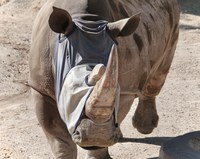Fly Mask Protects ABQ BioPark Rhino From Allergies
An animal at the BioPark Zoo has donned a new accessory. Guests may see Bertha, our Southern white rhinoceros, wearing a fly mask. The use of the fly mask is completely voluntary, and through extensive, gentle desensitization training (letting Bertha see, smell, and touch the mask of her own volition), Bertha has allowed trusted keepers to put the fly mask on and remove the fly mask for her care.
Bertha has allergies, and when her eyes water, they attract flies which aggravates the allergies. The fly mask helps keep flies away so she’s more comfortable. Bertha has been receiving other preventative care measures to treat her allergies, including voluntary allergy shots and antihistamine powder.
In the summer of 2023, Bertha’s eyes both had serious issues that began to affect her navigation. The ABQ BioPark veterinary staff partnered with a local veterinarian with eye trauma experience to assess them. Through examination, it was determined that both of her eyes had ulcers, so we began a regimen of medicated eye drops. After the treatment saw improvement for Bertha, her team turned their attention to how best to protect her for the 2024 season.
Animal care staff began searching for the company that had provided rhino-sized horse head masks to other facilities. The fly mask is made of a very lightweight mesh, and it fits loosely over her eyes. Bertha can easily see through the mask, and it’s a comfortable and effective way to improve her well-being on a daily basis.
The process to acclimate Bertha to the mask was a long one. Her care team started by laying the fly mask over a basket so she could see it from a distance. Over time, it was brought closer and held up for her to smell, and hear the sound of the velcro tabs. As always, the team watched her body language.
Then her care team progressed to touching her with it, using verbal cues like “ear” or “touch” so that she knew what to expect so as to not startle her. Everything was repeated on the other side of her head. A couple of months later, she could put the mask all the way on! She progressed in the time that she was able to have the mask on while she explored until she could finally wear it outside in her habitat comfortably. She’ll continue to have a choice everyday if she wears it or not.
Watch to see the training in action, and bring your question to the keeper chat on Friday, September 20, for World Rhino Day!

